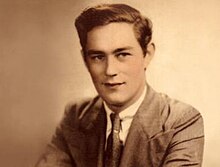Henry Gustav Molaison
| Henry Gustav Molaison | |
|---|---|

Molaison in 1953 before his surgery
|
|
| Born | February 26, 1926 Manchester, Connecticut |
| Died | December 2, 2008 (aged 82) Windsor Locks, Connecticut |
Henry Gustav Molaison (February 26, 1926 – December 2, 2008), known widely as H.M., was an American memory disorder patient who had a bilateral medial temporal lobectomy to surgically resect the anterior two thirds of his hippocampi, parahippocampal cortices, entorhinal cortices, piriform cortices, and amygdalae in an attempt to cure his epilepsy. He was widely studied from late 1957 until his death in 2008. His case played an important role in the development of theories that explain the link between brain function and memory, and in the development of cognitive neuropsychology, a branch of psychology that aims to understand how the structure and function of the brain relates to specific psychological processes. He resided in a care institute in Windsor Locks, Connecticut, where he was the subject of ongoing investigation.
Molaison's brain was kept at University of California, San Diego where it was sliced into histological sections on December 4, 2009. It was later moved to The M.I.N.D. Institute at UC Davis. The brain atlas constructed was made publicly available in 2014.
Henry Molaison was born on February 26, 1926, and experienced intractable epilepsy that has sometimes been attributed to a bicycle accident at the age of seven. (This accident was initially reported to have occurred at age nine, but was corrected by the patient's mother at a later stage.) He had partial seizures for many years, and then several tonic-clonic seizures following his 16th birthday. In 1953, he was referred to William Beecher Scoville, a neurosurgeon at Hartford Hospital, for treatment.
...
Wikipedia
